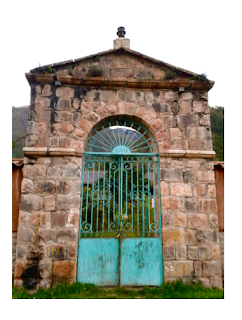Maggie in Peru: Adventures Under Southern Skies Part II: The Road toCancha Cancha
We stoop to enter Dorotea’s house while she shoos a chicken out and a kitten quickly follows. It takes my eyes a moment to adjust to the light, which is very faint, whose provenance is the open door and a fire on which various pots and kettles are boiling away. We are promptly offered steaming matés of an herb called “cancer,” which, evidently, works wonders on cancer. There is hardly a single herb here, it seems, which can escape some utility for the high Andes inhabitants. We greet each other in Quechua - Allianchu, Allianmi - and I introduce myself as the new Q’ente volunteer. I have brought bananas, which I thought might be a nice exotic treat to share, and they gladly tuck in. Luzmila tosses her banana peel into a far corner of the house, and as my eyes follow it, to my great surprise, a sudden flurry of life swells from under the bed to devour it - guinea pigs! I can get into the hang of this, and soon, we are all sending scraps of potato peelings their way as we recover our strength from the long hike up.
As Luzmila, Dorotea, and her husband prepare lunch, the weavers slowly begin to file in. They are all clothed in the traditional Andean fashion, with mantas around their shoulders and two versions of the tradtional Peruvian hat, or montera, on their heads. As I have noticed to be a custom of the rural villagers, they all have with them their drop spindles, which they can deftly operate while they do almost anything else. This particular group of weavers is very animated, and they have lots to talk about this month. We held the annual Q’ente Encuentro the week before, where representative weavers gather from all six of the communities with which Q’ente works to exchange news and ideas. Cancha Cancha’s weavers had been quite inspired by the exposure to the weavings and knowledge of the other communities.
As I squatted there in the dim smoky light of a one-room adobe hut, a ring of villagers around me gorgeously and traditionally dressed, speaking a tongue their ancestors spoke, I felt like an anthropologist in a century past. A huge smile began to spread involuntarily across my face as it dawned on me what an incredible blessing it was to be here at this moment in a remote village with these remarkable people; not as a tourist, but as a representative of an organization that is striving to preserve this ancient culture and empower its beautiful artisans. I’d dreamed ever since I was a little girl of being Margaret Mead, exploring foreign lands and exotic cultures, of knowing the world not for its histories in books but its totality of living wonders. I’ve been running away from home ever since I could walk in search of such curiosities, and my wanderlust at long last had brought me to this place of no small wonder. There is a child of ourselves which persists in our being our whole life, and that day in Cancha Cancha the child of me couldn’t have been more giddy to know that the world I’d set off for with a knapsack over my shoulder still exists, and for a moment, was a world which invited me in.




Comments
Post a Comment